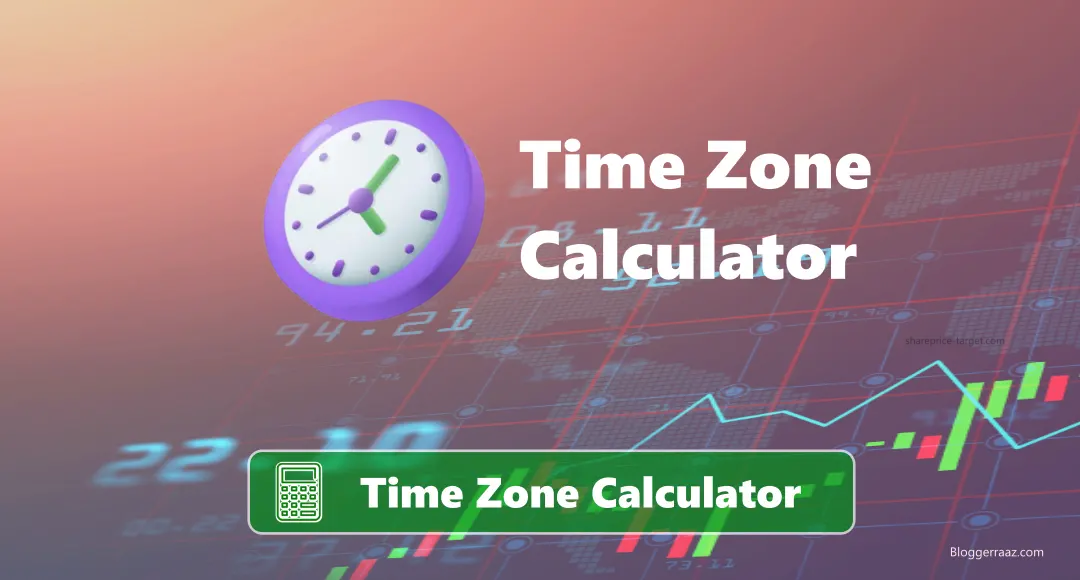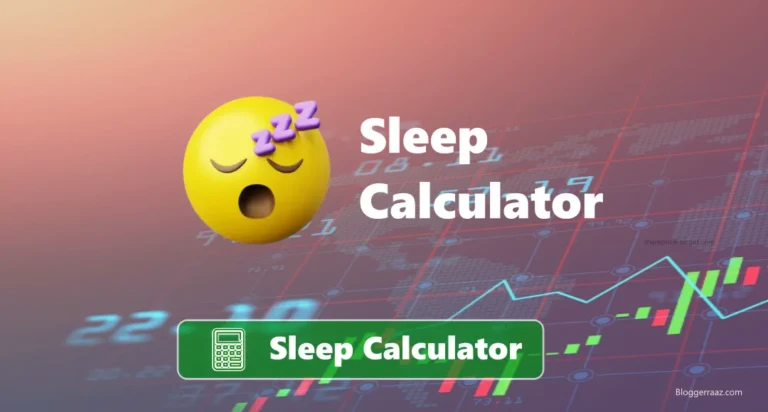Time Zone Calculator
A time zone calculator helps you calculate what time it is in different places around the world. It’s really helpful when you need to set up calls, meetings, or plan trips across different time zones. These tools show the time difference between locations and consider standard time (UTC) and Daylight Saving Time (DST). They automatically adjust for any DST changes, so you always know the right time. These calculators also help you pick the best time for meetings across different time zones. Some even show a map of time zones, making it easier to understand how time works in different countries.
What is Time Zone Calculator?
A time zone is a region on Earth where everyone follows the same time. These zones are usually based on a country’s longitude. Greenwich Mean Time (GMT) used to be the global standard for time, but now it’s mainly used in a few countries in Africa and Western Europe. Today, the world uses Coordinated Universal Time (UTC), which is based on very accurate atomic clocks and the Earth’s movements. Time zones are usually set by adding or subtracting hours from UTC, such as UTC+05:00 or UTC-03:00, and can range from UTC-12:00 to UTC+14:00.
🌍 Time Zone Calculator
Convert time between two different time zones easily.
How to use the Time Zone Calculator?
- Open the Time Zone Calculator on our website or app.
- Choose the place or time zone you are starting from.
- Type in the date and time you want to change.
- Pick the place or time zone you want to convert to.
- See the converted time right away.
- Add more cities if you want to check times in different places.
- Make sure the calculator adjusts for Daylight Saving Time automatically.
- Use the converted time to help plan meetings or events with people in other time zones.
World Time Zone Map
Time zones around the world can be different. Most countries started using standard time zones in 1929. Nepal was the last to adopt a time zone, doing so in 1956. Normally, time changes by 1 hour for every 15° of longitude, but this isn’t always the case. For example, China and India both use just one time zone, even though they are much larger than 15° of longitude. Russia has 11 time zones. So, while there’s a general way to set time zones, each country can do it differently and sometimes change it.
U.S. Time Zone Map
In the U.S., there are 9 time zones. Some of the most common ones are Eastern, Central, Mountain, and Pacific Time Zones, which cover most of the mainland U.S. For every 15° of longitude, there is a 1-hour time difference.
- Eastern Time Zone (ET): UTC-05:00 – covers 22 states in the eastern U.S. and parts of Canada, Mexico, Panama, and the Caribbean.
- Central Time Zone (CT): UTC-06:00 – covers parts of the U.S., Canada, Mexico, and Central America. Nine states are fully in this zone, while others share it with Mountain or Eastern Time.
- Mountain Time Zone (MT): UTC-07:00 – covers parts of the U.S., Canada, and Mexico. Five states are fully in this zone, while others share it with Pacific or Central Time.
- Pacific Time Zone (PT): UTC-08:00 – covers parts of the western U.S., Canada, and Mexico. States like California and Washington are fully in PT, while Alaska is split between Pacific and Alaska Time.
These time zones are usually set in relation to UTC and range from UTC-04:00 to UTC+10:00. Some of them also follow daylight saving time (DST), where the time shifts 1 hour closer to UTC during certain months. Some zones, like Atlantic, Samoa, and Chamorro, do not follow DST.
How the Time Zone Calculator Works?
A time zone calculator helps you know the exact time in two different places. It checks the time gap from Coordinated Universal Time (UTC) and also considers if Daylight Saving Time is used in any of those places. When you enter the names of two cities, countries, or time zones, the calculator quickly shows the correct local time for both. This makes it simple to plan calls, meetings, travel, or other activities across countries without getting mixed up. It is very useful for people working with others in different countries, students studying abroad, or anyone who wants to keep in touch with family and friends living far away.
Time Zone Conversion Table
| UTC Time | New York (EDT/EST) | London (BST/GMT) | Berlin (CEST/CET) | Dubai (GST) | India (IST) | China (CST) | Tokyo (JST) | Sydney (AEST/AEDT) |
| 00:00 | 20:00 (prev day) | 01:00 | 02:00 | 04:00 | 05:30 | 08:00 | 09:00 | 10:00 |
| 06:00 | 02:00 | 07:00 | 08:00 | 10:00 | 11:30 | 14:00 | 15:00 | 16:00 |
| 12:00 | 08:00 | 13:00 | 14:00 | 16:00 | 17:30 | 20:00 | 21:00 | 22:00 |
| 18:00 | 14:00 | 19:00 | 20:00 | 22:00 | 23:30 | 02:00 (+1) | 03:00 (+1) |
Applications of Time Zone Calculator
- Set up meetings with people in other countries.
- Working with a person who lives in a different time zone.
- Talking to customers or clients in other parts of the world.
- Planning online events like webinars for a global audience.
- Organising travel plans like flights and hotel check-ins.
- Making sure people around the world know when a live event starts.
- Changing computer or app times to match your local time.
- Set up automatic tasks on your computer at the right time.
- Making sure different apps or websites work together at the same time.
- Schedule online classes for students in different countries.
Why do we have time zones?
Time zones were created so that the time in each place matches when the Sun is in the sky. Before time zones, every place had its own time, which made things confusing as travel and communication got better. In 1884, the world decided on 24 time zones, with each zone covering one hour of Earth’s rotation, and the starting point set in Greenwich, England. This system helps everyone stay on the same page when it comes to time.
UTC (Universal Time Coordinated)
UTC is the main time system used all over the world to make sure clocks and time are the same everywhere. It does not change during the year, even when some countries use Daylight Saving Time. All other time zones are based on UTC, such as UTC+2 or UTC−5, which means they are a few hours ahead or behind UTC. It is used a lot in travel, computers, and worldwide communication so that people don’t get confused by different local times. It is almost the same as GMT (Greenwich Mean Time), but UTC is more exact because it uses very accurate atomic clocks and sometimes adds extra seconds, called leap seconds, to stay in line with the Earth’s movement.
DST (Daylight Saving Time)
Some countries, especially in Europe and North America, use daylight saving time (DST). They move the clock one hour forward in the spring and one hour back in the fall. This helps people to have more daylight during their work hours. But in places high in the mountains or near the equator, this doesn’t help much. In those places, sunrise and sunset times don’t match work hours well, or the amount of daylight doesn’t change much during the year.
Standard Time
Standard Time is the regular time used in a country when clocks are not changed for Daylight Saving Time (DST). It is based on the area’s time zone, which depends on how far it is from UTC. Each time zone is usually one hour different from the next. Standard Time stays the same all year, unless the country changes the clocks for a few months during DST. For example, if a place follows UTC+3 as its Standard Time, it might change to UTC+4 during DST. Standard Time helps everyone in different places follow the same system to keep track of time.
Time Difference
Time difference is how many hours one place’s time is ahead of or behind another place’s time. The world is split into different time zones, and each zone has its own local time based on how far it is from a main time called UTC. For example, if it is 3:00 PM in London but 8:00 PM in Karachi, the time difference is 5 hours. It helps people figure out what time it is in other countries, which is helpful for travel, meetings, and talking with friends or family far away.
GMT
GMT (Greenwich Mean Time) is the time at the main line that passes through Greenwich, London. It was the first time used worldwide before UTC was made. GMT shows the local time in Greenwich and helps people find out the time in other places. It stays the same all year and does not change for Daylight Saving Time. People use GMT to keep time simple and organised between different countries.
BST
BST (British Summer Time) is the time used in the UK during the summer. In spring, people move their clocks one hour ahead of the normal time to have more daylight in the evening. Then, in autumn, they move the clocks back to the normal time. BST helps people enjoy more daylight during the longer summer days.
What is the difference between UTC, GMT, and BST?
- UTC (Coordinated Universal Time) is the main time used all over the world. It stays the same all year and does not change for Daylight Saving Time. It is very accurate because it uses special clocks called atomic clocks.
- GMT (Greenwich Mean Time) is the time at the main line that goes through Greenwich, London. It is the same as UTC in winter and also does not change for Daylight Saving Time.
- BST (British Summer Time) is the time used in the UK during the summer. It is one hour ahead of GMT because the clocks are moved forward in the spring to have more daylight in the evening.
- So, UTC and GMT are almost the same most of the year, but BST is one hour ahead during the summer when clocks change for Daylight Saving Time.
Is time zone the same as local time?
Time zone and local time are different. A time zone is a region that shares the same basic time based on how far it is from UTC. Local time is the actual time people use in a city or place. It usually follows the time zone but can change during the year because of Daylight Saving Time when clocks move forward or backwards. This means local time can be different from the time zone at certain times.
Conclusion
A time zone calculator tells you the right time in different places around the world. It is very helpful when you want to plan meetings, calls, trips, or events with people in other countries. The calculator shows the time difference quickly and also changes the time automatically if a country uses Daylight Saving Time. It is based on UTC, which is the main world time, so the results are always correct. This makes it easy for anyone to know the exact local time without getting confused. Whether for work, study, travel, or talking with family and friends, a time zone calculator makes things much easier.
FAQs
Why do people use a time zone calculator?
People use it to plan meetings, calls, trips, or events with others in different countries without getting confused about time.
Does it change the time for Daylight Saving Time?
Yes, it updates the time automatically; the country uses Daylight Saving Time.
What time system does it follow?
It follows UTC (Universal Time), which is the main world time used everywhere to keep things accurate.
Can I check times in more than one city at once?
Yes, many time zone calculators let you add more than one city so you can compare times easily.
Do I need to know UTC to use the calculator?
No, you don’t need to know UTC. The calculator does all the work for you and shows the correct local time.
Can I use it on my phone or computer?
Yes, you can use most time zone calculators on both phones and computers.
Do all countries follow the same rules for time zones?
No, each country can set its own time zone, and some may not use Daylight Saving Time at all.
Yes, it is free to use.




